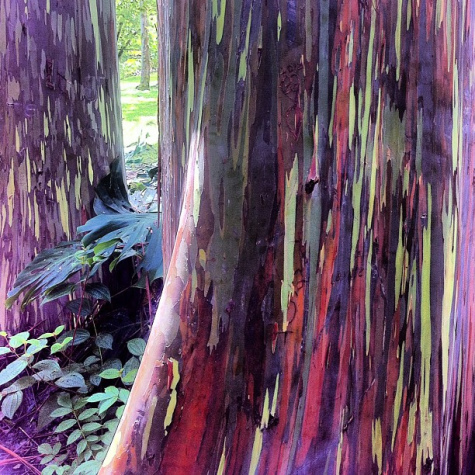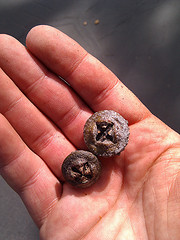 The other day, as our kids played around a big, messy tree–one with patchy bark and drooping sickle-shaped leaves–a friend told me she was going to show me a picture of a eucalyptus she knew I would love.
The other day, as our kids played around a big, messy tree–one with patchy bark and drooping sickle-shaped leaves–a friend told me she was going to show me a picture of a eucalyptus she knew I would love.
A eucalyptus? Not one of these troublesome trees, I thought. But then she held up her phone. I peered in at the photos, and then we grinned at each other. I did love it.
The photos were of a rainbow eucalyptus, which has bark that looks it’s been painted with every one of our kids’ favorite colors. The bark peels off in strips, and what’s left behind is chartreuse and purple, orange and amazing. According to one botanist, the tree’s thin, transparent layers of bark reveal the underlying chlorophyll and tannins, and how levels of each change over time as many layers of bark peel away. This species, Eucalyptus deglupta, grows in island forests of the Philippines and Indonesia.
The eucalyptus trees we have here has peeling bark, too, and they’re also from across the Pacific, but rainbows don’t beam out of their trunks. They’re actually a pretty sore subject in California. These trees, mostly blue gum, were brought in first to beautify the golden state—less gold, more green—and then as a potential wood product. They’re called gasoline trees in Australia, they’re called invasive species here—and yet they’re one of the state’s icons, and people tend to feel very strongly about them. (Just check out the comments on this story addressing eucalyptus issues in the Bay Area.
I’m not a eucalyptus hater, but I’ve always been skeptical, I guess, mainly for personal reasons. There was a grove of them behind the biosciences building at UC Berkeley that was both creepy at night and the site of multiple assaults. Many blame part of the rapid spread of the Oakland Hills fire on frost-burned eucalyptus—their oils, their leaf litter and shards of bark.
Even still, later that night that night I was doing what those centuries-old Californians did—dreaming of planting my own neighborhood eucalyptus invasion. Rainbow trees, they could do anything! If people saw these trees, wars would stop, credit card companies would stop charging interest, and we’d all break out into song, right?
Unfortunately, these trees are extremely water-loving and extremely tall—liable to get whipped around in strong Santa Ana winds. Planting a 200-foot tree next to our 15-foot roofs during a drought would be plain foolhardy.
 So we are resigned to the trees we have. And, more often than I’d realized, delighted by them. As winter comes on, thousands of monarchs will cluster like grapes on the eucalyptus in a nearby grove. The butterflies can be hard to see, looking like so many dead leaves in the dim light beneath the canopy. But when the sun pushes its way through, the butterflies rise from their perches and swirl like orange confetti among the trees.
So we are resigned to the trees we have. And, more often than I’d realized, delighted by them. As winter comes on, thousands of monarchs will cluster like grapes on the eucalyptus in a nearby grove. The butterflies can be hard to see, looking like so many dead leaves in the dim light beneath the canopy. But when the sun pushes its way through, the butterflies rise from their perches and swirl like orange confetti among the trees.
Even at the park the other day, all the kids took pieces of the peeling bark and sliced them through the air like cutlasses before racing back to their pirate ship. Later, I found the small seed pods that mark the eucalyptus stuck in the pockets of two different pairs of pants.
I held one in my hand for a while and looked at it. I’d collected these pods once, too. There’s always a marking on one end—sometimes it’s a star, other times it’s a Y-shaped slit. This one had a small cross. Long after the pants were clean, the pod sat next to the dryer, a treasure of uncertain value that I couldn’t make myself throw away.
—
Images via Flickr by Jay Hickey and Cesar Harada
One thought on “Rainbow Connection”
Comments are closed.